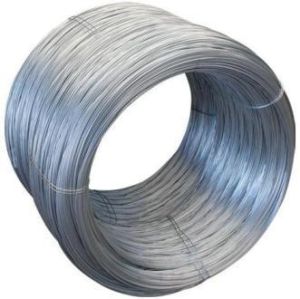
Wire Rods
Wire Rods are an alloyed or non-alloyed form of steel that are available in various cross-sectional shapes, such as, round, rectangular, etc. They usually have a diameter ranging from 5.5mm to 42mm. Wire rods are used across various industrial verticals, including the automobile, engineering, construction and consumer goods industries, to name a few. They are manufactured from steel billets or blooms in wire rod mills according into various forms (cross-sections) based on the various industrial requirements. Wire rods of various thickness ranging from 5.5mm to 42mm are available in the industry. Within the industry, wire rods are classified as low carbon wire rods, high carbon wire rods etc. depending on various criteria with amount of carbon being one of them. Low Carbon wire rods – Carbon content ≤ 0.15% Medium low carbon wire rods – Carbon >0.15% ≤ 0.23% Medium high carbon wire rods – Carbon >0.23% ≤ 0.44% High carbon wire rods – Carbon > 0.44% Wire Rods are used in a wide range of applications. From construction industry to the automotive industry, they can be seen being used across the verticals. Wired rods can be used for making: General purpose Wires, Agriculture Wires, Bush Wires, Chain Rivet Wires, Detonator Wires, Umbrella Ribs, Upholstery Wires, Cycle Spokes, Stapler Pin Wires, Needle Wires, Safety Pin Wires, Card Clothing Wires, Vineyard Wires and earth wires For production of automobile components like Screws, Fasteners, Bush, Spline, Socket, Connecting Rod, Gear, Engine Shaft, Connecting Rod, Spindles Fasteners, Bolts, Rivets, Screws for general applications Electrode Wires Coil Springs Wire Ropes and more
...more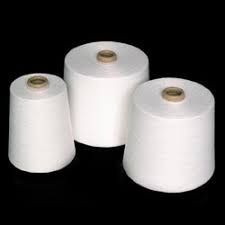
Viscose Yarn
Viscose is a semi-synthetic fibre which was earlier known as viscose rayon. The Yarn is made of cellulose fibre which is regenerated. Many products are made with this fibre because it is smooth and cool as compared to other fibres. It is highly absorbent and it is very similar to cotton. Viscose is used for making a variety of clothing such as dresses, skirts and innerwear. Viscose does not need an introduction because it is a popular name in the fibre industry. Viscose fabric lets you breathe easy and the current designs in the fashion industry have made this fibre a popular choice.
...more
TMT Bars
TMT Bars are thermo-mechanical treated reinforcement bars that find extensive use in the construction industry. These reinforcement bars are manufactured using thermo mechanical treatment of the steel bars in order to achieve high strength and ductility. The high strength TMT bars are considered ideal for any construction purpose where a high yield strength and low weight is desirable. Due to its exceptionally high strength and high yielding capacity, TMT bars form an important part of the construction business. The thermo mechanically treated steel bars have lesser impurities, and are prone to lesser design failures and hence are used for Reinforced Cement Concrete (RCC) Work. High quality TMT bars are used in the construction of industrial as well as residential structures including flyovers, bridges, dams, ports and more. TMT bars are not only stronger and lighter that steel, they come across as cost-efficient and safe solution for construction purposes. Let us look at some of the key benefits of TMT bars: High ductility High strength and toughness Better elongation values Higher resistance to corrosion Earthquake resistant Excellent weld-ability Superior rib configuration Excellent weld-ability Bonds better with cement and concrete
...more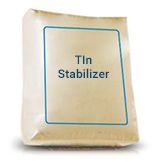
Tin Stabiliser
Tin Stabilisers are generally used as heat stabilisation for PVC. They constitute a central tin atom surrounded by Alkyl or Acid groups. Commercial Tin Stabilisers have mono and di alkyl salts mixed in varying ratios. Tin Heat Stabilisers for PVC can be classified into two categories namely, Thio Acid half-Esters, and Dicarboxylic half Esters. Thio Acid half-Esters are also known as Thiotins or Mercaptides. Dicarboxylic half Esters are also called Maleates or Carboxylates. Tin Stabilisers are mostly based on Methyl, Butyl, or Octyl groups. Tin Stabilisers are available both in Solid as well as Liquid form. Solid forms may be Paste or Solvent-free form. Tin Stabilisers have wide applications in plasticized PVC because they can be easily handled and integrated with liquid plasticiser dosing systems. Usage Tin Stabilisers used in PVC compounds are used for making sheets, bottles, profiles, injection moulded fittings, credit cards, blister packs, food containers, and display trays. They are also used for making PVC Pipes and Fittings, PVC Films, Hose Pipes, and Soft Tubes. Other applications include manufacture of Crystal PVC sheets, blow moulding, calendaring, extrusion etc. Tin Stabilisers are not suited for skin contact which is why they are strictly excluded from applications where skin contact is present, even if there is a need. However, there are some food applications of Tin Stabilisers, never exceeding 2%. Tin Stabilisers are an excellent heat stabiliser replacement for toxic heat stabilisers that were previously used in PVC compounds. Tin Stabilisers are also mixed with Vinyl Polymers to create finished products.
...more
Steel Tubes
Steel tubes is an ideal choice for high-profile industrial projects as well as in the manufacture of domestic products. They are known for their high strength, ductility and tensile strength. They can easily withstand heavy blows, knocks and scratches associated with daily use. Also, these steel tubes may be excessively stretched and shaped to form arches or curved items, based on the industrial requirement. Steel tubes have largely been used in the construction and manufacturing industries, owing to their versatile nature. The tubes can be made into different shapes, arched, or reshaped into any other form as per the design criteria. Also, they can be used with a wide range of general workshop equipment. This reduces the cost and effort associated with the designing. Hence, they are also used for making strong and long lasting benches. Steel tubes can be used for: Structural purposes: for scaffolding, railing, making stairs, tents etc. Industrial applications: barricading, tools, supports, trolleys, machinery, poles Automobile Parts: manufacturing of chassis, steering, tools, parts, Everyday applications: making of doors, railings, stairs, decoration, tents and fencing Furniture items: Chairs, Tables, Racks, Storage Systems Making industrial equipment and more
...more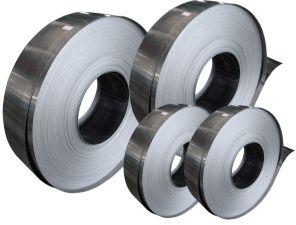
Steel Strips
The traditional method of making Steel Strips is by using recycled steel. The newest method of Steel Preparation begins by first rolling steel rod stock and strips of appropriate dimensions into steel strapping of specified thickness. The resulting steel strapping is then heated with electrical resistance by passing electric current through it using roller contacts. When the strip stock reaches an appropriate temperature, it is hot rolled and heat treated. Heat Treatments are varied and chosen per the type of structural constitution required such as Pearlite, Marsenite, Bainite etc. It can be modified to obtain various properties such as Tensile Strength, Ductility etc. The resultant product is either coiled or cold rolled. This method results in energy savings that were hard to achieve in conventional heat furnaces. Steel Strips are used for different industrial applications. Most common uses include Body Panels, Automotive Components, Tubes, Appliances like Refrigerators, Washers, and Dryers, Building Materials, Electric Components etc. Steel Strips have excellent forming and deep crawling capabilities. Cold Rolled Steel Strips possess excellent surface quality, cold formability, and uniform mechanical properties. Major areas of application include Civil Engineering, Tube Industry, Section Industry, Steel Service Centres, Re-Rollers and, Steel Trade. The Housing Industry uses Steel Strips for Roofing, Cladding, Drainage, and Household Appliances. The Automotive Industry also uses Steel Strips spanning Automotive sub-suppliers and the commercial vehicle industry. Hot Water Boilers, Stoves, Clothes Dryers, Dishwashers are few other areas of use for Steel Strips. The Radiator Industry also uses Steel Strips.
...more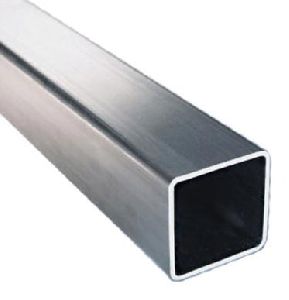
Steel Square Tubes
The making of Steel Square Tubes follows the same process that is used to make Steel Rectangular Tubes wherein a flat steel plate is moulded and the edges are refined. It is prepared for welding where the edges are welded to form the mother tube. The mother tube then goes through a series of shaping strands. When the mother tube is in the shaping strand, it is given a square shape, instead of rectangular. The four angles in a Steel Square Tube are highly uniform with high intensity. Steel Square Tubes have low manufacturing cost. Its high strength-to-weight ratio makes it desirable for welding, forming, punching and drilling. Steel Square Tubes are lightweight alternatives to solid steel products such as I-Beams and Wide Flanges. Square and Rectangular Steel Tubes differ in characteristics but they are both used in Building and Construction Applications. They are mostly used to get maximum floor area in steel housing and high rise steel buildings. Steel Square Tubes can be easily recycled. Buildings, Highway Guardrails, Signage, Support Columns, Trusses, Bridges, Heavy Equipment, Storage Systems, and Exercise Equipment use Steel Square Tubes. Other Industries that make use of Steel Square Tubes include the Furniture Industry, and for Domestic Applications like Bus Body, Fencing etc. Stainless Steel Square Tubes are mostly used in applications where the Tubes are exposed to water like the Construction, Automotive, Appliances, Furniture, and Agriculture Industries. Major Applications of Stainless Steel Square Tubes include Fabrication of Containers, Architecture, Conveyors, Bicycles, Automotive Fabrications, Structural Support for Industrial Plants, Buildings and Bridges, and for General Engineering Purposes.
...more
Steel Round Bar
Steel Bars are manufactured through Ladle Refining Furnace Degassing Process. This combined Refining Process is followed by a Bloom Continuous Caster process. Here, Bloom Casters are produced with large cross sections. After this comes the rolling process in which the Bloom Casters are sent into a 2500 ton in-line press. Finally, steel bars are rolled out from a Full Continuous V-H Rolling Machine. This machine ensures that only highly rigid and accurate steel bars are rolled out. The resultant products are examined thoroughly in an automatic inspection line to ensure maximum quality and accuracy of the product. The Diameter and Length of the product is measured using Laser measuring equipment. The overall quality measurement is known as the Left Footstep process. Steel Round Bars are mostly made from stainless steel. Due to the high corrosion resistant and acid resistant properties of Stainless Steel, these round bars are used for Machining, as Fasteners, for Grills and Construction purposes. Machining applications make use of their high cutting speed and long tool life. Steel Round Bars are available in different grades like Duplex and Super-Duplex Stainless Steel. They are also available as peel-turned, burnished or rough machined surface. Mild Steel Round Bars are used as tensile stress for Reinforced Cement Concrete (RCC) Slab Beams. Deformed steel round bars are used in construction projects by structural engineers. Most common use of Steel Round Bars are for Pump Shafts, Machined Components, Valves, Dairy Equipment, Machine Tools, Pins, Hinges, Surgical Parts, Metal Parts etc.
...more
Steel Rectangular Tubes
Steel Rectangular Tubes are also referred to as Hollow Structural Sections. This is a terminology most commonly used in Engineering and Construction. The manufacturing process of Steel Rectangular Tubes does not vary greatly from that of Square Rectangular Tubes or Pipes. First, a flat steel plate is moulded to change shape. The edges are refined and readied for welding. The edges are then welded to form the mother tube. The mother tube is then passed through a series of shaping strands. These strands turn the mother tube into the desired shape (steel or rectangular). Steel Rectangular Tubes conform to the American ASTM A500 or ASTM A1085 Standards. To improve the fire rating and robustness of Steel Rectangular Tubes, it is usually filled with concrete. Steel Rectangular Tubes are used in various industries and in different applications. Common Industrial Applications include where extreme temperature, pressure and destructive tolerance is required. Common Domestic Applications include Kitchen Appliances and Gas Pipes. The Construction and Engineering Industry uses Steel Rectangular Tubes for welded steel frames and steel scaffolding. Automobile manufacturers use them for internal vehicle parts like the Fuel Injection system and Vehicle Control System. More applications include manufacture of Furniture, Display Stands, Shop Fittings, Clothes Rails, Storage, Racking, and General Steel Fabrications. Steel Rectangular Tubes are best suited for mechanical uses because it has close tolerance, good finish, and dense structure.
...more
Steel Pipe
The most basic method of producing a Steel Pipe is where raw steel is casted and then is stretched out into a seamless tube. In this process, the pipe is formed on a continuous or semi-continuous production line. Another method is to seal the edges together by welding. The whole manufacturing process of Steel Pipes is divided into 5 stages namely, Ingot Production, Production of Booms and Slabs, Additional Processing, Pipe Making and Final processing. In the Ingot Production phase, molten steel is produced and poured into iron moulds where it cools to form Ingots. These Ingots are further processed into Booms and Slabs, after which they’re converted into skelp and billets that are finally made into Steel Pipes. Steel Pipes make excellent water pipes. They are also called domestic pipes and are used in building and construction sectors where they are employed for housing societies, offices, etc. Steel Pipes are also used as Casing for Oil and Gas. Stainless Steel Pipes make excellent sewage pipes because they don’t rust, don’t leak, and have a long life. Steel Pipes exhibit high strength and chemical composition standards because of which they are majorly used in Construction and for similar purposes like Fencing, Handrails, Columns, Stoves, exhaust pipes, chimney pipes, poles etc. Steel Pipes are extensively used for Scaffolding purposes in the Construction sector. The Energy Industry also uses Steel Pipes because they can be easily maintained and are very reliable.
...more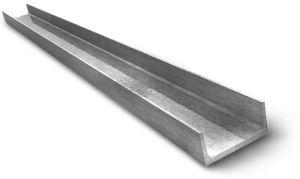
Steel Channel
A Steel Channel is a C-shaped Structure made from Mild Steel that is hot rolled. The inside corners of the steel channel have specific radii that provides it the required strength and rigidity to support steel angles, and for various other structural and construction projects. They are fairly easy to prepare with the right equipment and dimensions. Steel Channels commonly follow the dimensional standards of ASTM 36. Post hot-rolling, the Steel Channels are generally subjected to additional inline fabrication. After the fabrication process, it is either painted or sent for galvanisation to make it resistant to corrosion. Steel Channels can be cut, drilled, or machined per requirements. They can also be welded with ease. Large Channels are usually manufactured using laser fusion technology. Steel Channels fit both Indoor and Outdoor usage. They are normally employed for general construction. Few examples of use are as Lintel above doors and as support for floor joists. Indoor usage is mostly as Holders, Covers, Frames, Inserts, Décor, Brackets, Tracks, Slides, Posts etc. Outdoor usage include as Standards, Supports, Reinforcements, Stiffeners, Railings, Rails, Rims, Purlins, Sub-girts, Girts, etc. Other industries that use Steel Channels are Ship Building and Automotive Industries. Majority of Manufacturing Industries make passive use of Steel Channels. They are also used for Repairs. Construction of Bridges and Machinery also make use of Steel Channels. Civil Engineering and Building/Construction are the two main Industrial sectors that see high demand for Steel Channels. Their Corrosion Resistant and high support properties make them useful in these two sectors.
...more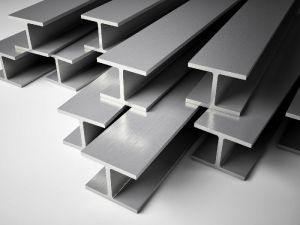
Steel Beams
Steel Beams are also known as “I-Beams”. I-Beams are made even using Aluminium or other metals. Structural Steel Beams are the most popular and are used for a variety of purposes owing to their usefulness. Steel Beams are made either by Rolling namely, hot rolling, cold rolling, and extrusion or by the Plate Girder process namely, by welding, bolting, or riveting plates. Before preparation, specific dimensions and measurements are specified for the Steel Beams to perfect their shape. The exact dimensions are crucial in ensuring the right size that will yield the best results when the finished product is used. To achieve high accuracy in manufacturing, Steel Beams are made using Laser Fusion Technology by Engineers who mix the right proportion of thickness and material grades. Steel Beams shaped in the form of the capital letter ‘I’ are mostly used in industries that need tapered flanges. “W-shaped” Steel Beams, also called wide flange beams are used in residential housing and construction purposes. There are also “H-Flanges” that are a bit more heavier and longer than I-Flanges but look almost the same. Due to their useful shapes and good strength to weight ratio, they are best suited for construction. Industrial sheds, Bridges and Building structures mostly use steel beams. They can expertly handle vertical gravitational forces and horizontal earthquake or wind forces. Transmission Line Towers and Frames also see extensive usage of Steel Beams. They form strong bonds with Brickwork and Lintel which makes them perfect for structural projects.
...more
Steel angle
Steel Angle is essentially ‘steel shape’ with low carbon that is hot rolled. It is the most popular among all steel shapes. It is angled at 90° which makes it a strong and sturdy product that is used for various applications. Steel Angles have a bar shape and it conforms to the ASTM A36 Steel Standard. Steel Angles can be either hot rolled or cold rolled. Hot Rolled Steel angles are mostly used in industries and manufacturing units because they have a rough surface that makes them suitable for different applications. They can also be made capable of resisting corrosion through galvanisation. Hot Rolled Steel Angles are made from low carbon steel that are unalloyed. Some uses of the Steel Angles are in the manufacture of frames, fabrications, shelves, brackets, vehicle building, construction, and maintenance. Structural usage of Steel Angles is maximum compared to any other sector. Examples include riveted, bolted, or welded construction of buildings, bridges, machinery etc. A few other uses are for brooms, rails, braces, cross-members, liners, truck trailers, truck beds, racks etc. More uses of the Steel Angle include construction of bicycle racks, motor mounts etc. Steel Angles comes in different lengths and sizes. They can also be cut to the desired length as per requirements. Additional rust protection can be achieved by red oxide coating or hammarite metal spray painting to give it an extra finish depending upon the application.
...more
Stainless Steel Square Bar
Stainless Steel is processed into Square Bars. First, the steel is moulded. Next, the stainless steel is subjected to different temperatures to increase the tensile strength of the steel. After this, the steel stock is passed through roller pairs. During this rolling process, the steel is imparted different temperatures depending on the application it will be used for. The Rolling process may be one of three types namely, Hot Rolling, Cold Rolling, or Cold Drawn Rolling. In Hot Rolling, the grainstructure of the steel should be altered. Thus, the temperature of steel must be higher than recrystallization temperature. Cold Rolling is generally performed in room temperature since the steel temperature must be lower than the recrystallization temperature. Cold Drawn Rolling is like Cold Rolling in that it is performed in room temperature but here, the steel turns into a wire-like form. Square shaped steel bars are machinable and corrosion resistant. They are used in the manufacture of products such as general machining screws. The major applications of Steel Square Bars are in Engineering Construction, Residential Construction, Non-Residential Construction, Mining Infrastructure, Transport, and Storage. Hot Rolled Steel Square Bars can be easily cut, welded, formed, or machined. This makes them best suited for general structural fabrication and repairs for Industrial Maintenance. Hot Rolled Bars have a grainy finish and have rounded corners. Cold Rolled Steel Square Bars have smooth surfaces with sharp corners. They have highly accurate dimensions unlike Hot Rolled Bars. They are best suited as shafts, machine mounts, fixtures etc.
...more
Stainless Steel Sheet
Stainless Steel Sheets are highly preferred in a wide range of industries for their high corrosion resistance. From being used in the manufacturing of cookware to high profile industrial equipment, stainless sheets have emerged as one of the highly sought after industrial raw materials. Stainless steel sheets also tend to exhibit greater resistance at higher temperatures. They are used in applications that call for greater degrees of temperature tolerance. These sheets are formed by using the hot rolling process to produce flat thin pieces that can be easily formed into any shape. Stainless Steel Sheets are manufactured from stainless steel flats as the raw material. These are passed through the hot rolling units and hot rolled at a certain high temperature, which is called the recrystallisation temperature (for steel it is 1000?F). Once hot rolling is done, the resultant product is taken for annealing in the cold rolled annealing furnace. The process of annealing makes the metal more ductile and malleable. Next, the hot rolled, annealed steel product is now pickled using an acid-based solution to get rid of any surface oxide or furnace scale.
...more
Stainless-Steel-Coil
Stainless Steel Coils are one of the most sought after types of raw material in the construction and manufacturing industries. Thanks to their distinct mechanical and physical properties, stainless steel coils have been widely used in the production of kitchen appliances to industrial equipment. They are strong, resist corrosion, are light in weight and require low maintenance. Also, they are flexible and easily meet the requirements of a range of design criteria. Within the industry (especially manufacturing), numerous grades of stainless steel coils can be found, each with different properties and usability. Stainless steel coil is manufactured by hot rolling stainless steel slabs in a reheat furnace. The hot rolling process is carried out at a certain high temperature. This temperature is known as the recrystallization temperature in the industry, which is between 1,100° C to 1,300° C, which often depends on the grade of the steel used for the manufacturing process. The steel slabs are continuously run through heating and rolling mills. The resultant product is then suitably coiled. Post hot rolling and coiling, the stainless steel coils are passed through the annealing and pickling lines to get softer and brighter surface finish, free of any oxide layers and impurities.
...more
Slub Yarn
Slub yarns have tensile properties and are abrasion resistant which also depends somehow on the Slub parameter. The Slub yarns are also very much susceptible to damage during their usage due to the lack of migration of the fibres in the base and the injected yarns. Despite all the properties of Slub yarn, they are all tensile sensitive in nature. Ground Slub yarn is a simple yet fancy type of yarn whose appearance is attained due to the variation of linear yarn density during the spinning process. A ground Slub yarn is formed out of a single structure that eventually has two parts. The two parts are Slub part and base yarn part. There are methods to calculate the Slub yarns which are mathematically proved. The mathematical calculations give out the correct number of Slub yarns. Different types of Slub yarns Depending on the thickness and the Slub length the yarn can be classified into two different types. Some useful information regarding these two varieties is explained below. Multicount yarn – when it comes to multi count yarn, then the number of thread changes where as the number of twists remains unaltered. This leads to spinning variation in the fabric that provides an excellent colour combination Multi-twist yarn – in this type of Slub yarns, the a number of yarn remain same but the number of twist changes. Owing to this variation leads to different texture in the fabric and colour also gets altered.
...more
Rectangular Steel Bars
Rectangular Steel Bars are rectangular shaped pieces of hot rolled steel. They are long and flat and are mostly used in places where shape and tolerance of the product is not mandatory. These Bars are also made from Cold Rolled Steel, Stainless Steel, Alloy Steel, Tool Steel etc. Hot Rolled Steel Rectangular Bars are also referred to as Hot Rolled Flat Bars. They are less expensive than cold rolled steel rectangular bars. Cold Rolled Steel Rectangular Bars or Cold Rolled Flat Bars have sharp corners and edges. It is also smoother than hot rolled bars. Stainless Steel Rectangular Bars resist corrosion, staining, and rust, excellently. Alloy Steel Rectangular Bars are prepared by the addition of alloying elements like Manganese and Nickel that render it high strength and toughness. Steel Rectangular Bars are available in normalised, annealed, spheroidized annealed, quenched (hardened), or tempered form. They are mostly used in applications such as building of bridges, Engineering, Construction, Oil Field, Offshore, Shipbuilding, Die Making, Nuclear Projects, Marine Projects, Medicine, Instrumentation etc. Hot Rolled Steel Rectangular Bars are used in Trailers, Walkways, Ramps, for Structural support and in general fabrication. Cold Rolled Steel is used for manufacture of parts that require cold forming like Crimping, Swaging, or Bending. It is also used for carburised parts that need soft core and high surface hardness like King Pins, Gears, Dogs etc. Stainless Steel Rectangular Bars are mainly used in Architecture and Cookware Industrial sectors.
...more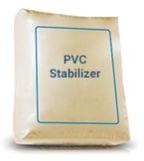
pvc stabiliser
PVC Stabilisers are added either directly into PVC or in combination to prevent oxidation, chain scission, uncontrolled recombination, and cross-linking reactions caused by photo oxidation. Essentially, they protect PVC from the harmful effects of extreme temperature and ultraviolet radiations. PVC Stabilisers are of different types like Heat Stabilisers which are mainly used in Construction projects. Antioxidants are PVC Stabilisers that prevent oxidation of PVC from taking place due to atmospheric oxygen. Hindered amine light stabilizers are PVC Stabilizers that scavenge radicals produced by weathering. The next type of PVC Stabilisers are UV absorbers. They dissipate energy absorbed by UV rays. Antiozonants are PVC Stabilisers that prevent degradation of materials cause by Ozone gas present in the atmosphere. Lastly, PVC Stabilisers are available in the form of Organosulfur Compounds that thermally stabilize polymers. Usage PVC Stabilisers are mainly used in the manufacture of Pipes and Fittings, Window Profiles, Rigid and semi-rigid films, wires and cables, coatings, and flooring etc. PVC Stabilisers are available in the form of Heat and UV Stabilisers, Flame Retardants, Smoke Suppressants, Plasticizers, Processing Aids, Impact Modifiers, Thermal Modifiers, Pigments, and Fillers that are added to PVC for strengthening purposes. The applications of a PVC Stabiliser are in all places where PVC is used. PVC is widely used in construction material, medical devices, children’s toys, protective housing for cables and wires, manufacture of credit cards etc. PVC is also used in rubber seals, vinyl fabrics, and automotive parts. Impact Modifier/Processing Aid PVC Stabilisers provide softness and flexibility that PVC does not normally have.
...more
Ppgl Sheet
PPGL Sheets are prepared by combining the strength of steel with anti-corrosive capabilities of a metal coating like Zinc or Aluminium. It is exceptionally resistant to weather and environmental degradations and can be punched, pressed, roll-formed, or joined in any way possible per requirement. They are made in a variety of specifications to suit different applications. They are lightweight and strong for easy placement and to provide high durability. They do not crack under pressure and are made to superior quality. Our suppliers provide PPGL Sheets made using the finest machinery and highly skilled engineers. Our product is superior in quality and has a fine finishing. The steel is properly galvanised to meet industry standards and the aluminium coating is made to display high strength and tolerance. Some of the applications of PPGL Sheets include Lining for Oil Tanks, in Factories, Educational Institutions, and Labs. Nuclear Power Plants, Electricity Boards, and Refineries (mainly, DM Water Plants) use PPGL Sheets.
...more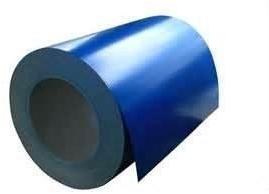
ppgl coil
PPGL Coil is prepared by combining Zinc Coated Steel Sheets and 55% Aluminum. The resulting product then has to be coated with Organic substances. Finally, it has to undergo a Paint Coating. This step is what results in the term ‘pre-painted’. PPGL Coils exhibit high degrees of strength and dimensional accuracy for use in various manufacturing industries spanning a wide range of sectors. The actual finished raw material must possess high thermal conductivity and must be able to resist corrosion. To equip the product with corrosion resistance, the finished product is usually dipped in hot liquid zinc. It can be welded as per industry requirement. Our suppliers provide the product that has a high quality finish and a long shelf life. A number of kitchen appliances such as Ovens, Ranges, Sinks, Kitchen Units, Shelves, Toilet Strands, and Cooker Wrapper also need PPGL Coils for manufacture. The Agriculture Industry also uses PPGL Coils for making Drying Machines, Farm Equipment, Greenhouses, Silos, Barns, and Sheds. General everyday products like Vending Machines, Display Cases, Cans, Bins, and Signboards also need PPGL Coils for preparation.
...more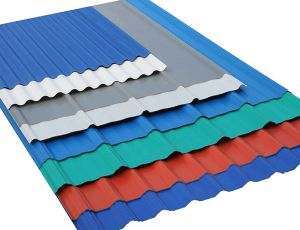
ppgi sheet
PPGI Sheets are sheets of pre-painted or pre-coated Steel that display high durability, and resistance against weather and UV rays from sunlight. As such, they are widely used as roofing sheets for buildings and construction. They do not undergo corrosion owing to atmospheric conditions and can be easily installed through a simple technique. PPGI Sheets are abbreviated from Pre-Painted Galvanised Iron. These sheets exhibit high strength and resilience and almost never leak or corrode. They are usually available in attractive colours and designs per preference. The metallic coating on these sheets are usually of Zinc or Aluminium. The thickness of this paint coating is usually between 16-20 microns. Surprisingly, PPGI Steel Sheets are very light weight and easy to manoeuvre. Buildings like Detached Houses, Terraced Houses, Residential Multi-Storey Buildings, and Agricultural Constructions mainly have PPGI Steel Roofing. They can be fastened securely and they keep excess noise at bay. PPGI Sheets also have excellent thermal properties and thus can keep the interiors of a building warm during winter and cool during scorching heat.
...more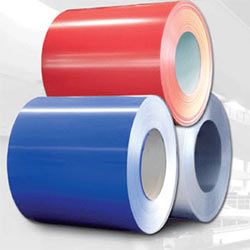
Ppgi Coil
This product is a coil of PPGI. PPGI is made by painting of Galvanized Iron prior to formation. Galvanized Iron is obtained when coated steel is continuously hot dipped to form Zinc of purity greater than 99%. Although the term PPGI is used loosely sometimes to refer to steel with various metallic coatings like Aluminum, Alloys of Zinc/Aluminum, Zinc/Iron and Zinc/Aluminum/Magnesium; in an exact sense, it refers to steel coated with zinc before formation (Pre-Painted Zinc Coated Steel). The Steel Substrate for PPGI is first produced through a CGL (Continuous Galvanizing Line) process after which it is coated with the metal and readied for preparation/manufacturing of various products. Before PPGI is ready to be converted into products, it is cleaned, pre-treated, and protected with various layers of organic coating and then sent for production. Common furniture types that require PPGI Coils for manufacture include Steel Furniture and Venetian Blinds. SMEs belonging to these sectors are in demand of the PPGI Coils and we provide them with bulk material by partnering with top PPGI Coil vendors who supply high quality, pure PPGI in Coil form.
...more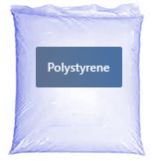
Polystyrene
Polystyrene is a synthetic polymer manufactured from the monomer called styrene. It is one of the most widely used plastics due to its cost effectiveness and durability in normal atmospheric conditions. Polystyrene is thermoplastic in nature i.e. it is solid in natural state but flows when heated above 100 degrees Celsius. Structurally, it is a hydrocarbon with alternating carbons and benzene rings. Though polystyrene has numerous applications, it is not bio-degradable and hence considered to be anti-environment. This is due to the fact that it is inert and on burning, releases carbon dioxide. Polystyrene is prepared by a process called polymerisation, wherein monomers link together to form long chains. Polystyrene comes in several forms, listed below: Moulded Polystyrene: This is the most common form. The shape is derived through vacuum forming or injection moulding. Highly rigid and durable, it finds wide applications in lab equipment, license plates, device housings, etc. Foam Polystyrene: This is a closed-cell foam which is rigid, tough and has high thermal insulation properties. When ingrained with graphite, it has even higher insulation. However, despite having closed cells, this form is not completely water-proof. Foam polystyrene can have two sub-forms: Expanded Polystyrene Foam: This form is far more rigid and durable with closed cells and hence it is used for refrigerator trays, bowls, etc. Extruded Polystyrene Foam: This variant provides a better surface roughness than the above variant and is commonly used in architectural models. There are two common types of Polystyrene: General Purpose Polystyrene (GPPS): For applications where strength does not matter much, this brittle, but rigid and inexpensive form of polystyrene is used. High Impact Polystyrene (HIPS): Due to its inherent fragile nature, pure polystyrene is not suitable for building sturdy items such as toys and appliance parts. It is mixed with 5-10% butadiene rubber to produce a robust and strong substance called High Impact Polystyrene or HIPS. This is commonly promoted as ‘high impact plastics’.
...moreBe first to Rate
Rate This